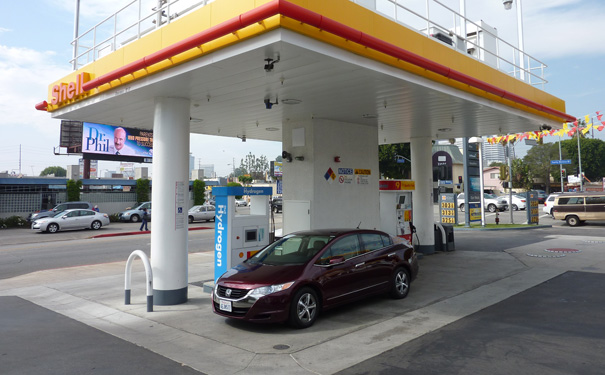While Toyota and Volkswagen – the world’s two biggest car makers – are locked in a battle for global sales leadership over the next decade, driven by a new generation of hybrid and electric cars, Japanese maker Honda is working on technology that may well leapfrog them both. Most big car companies have experimented with hydrogen-powered passenger vehicles behind closed doors and on private test tracks, but Honda is now putting them in the hands of real-world customers, from college professors to movie stars. And the occasional journalist.
The Clarity is Honda’s second hydrogen vehicle. With its sleek, futuristic lines, four doors and a boot, the Clarity is a big step from the original box-shaped experimental vehicle that appeared in 2002. That vehicle was loaned to a small number of fleets with access to hydrogen refueling points.
The Clarity, on the other hand, has been set free and put in the hands of about a dozen VIPs in California, including movie stars Jamie Lee Curtis and Christopher Guest. There is also a small study group of customers testing the Clarity in Japan.
Owners pay $US600 a month to lease the Clarity and can refuel at one of three Shell hydrogen retail points in California.
Hydrogen refueling points are key to the experiment, and the future success of the technology. It’s a classic chicken versus the egg story. Which comes first: hydrogen cars or hydrogen refueling stations? (In Australia there is one hydrogen refueling point – but it is based at a bus terminal in Perth.)
The challenge for hydrogen is that it is a highly volatile substance that is hard to transport, store and, until recently, dispense. But it is one of the most plentiful elements on the planet, so if we can run cars on it, there could well be a bright future beyond petrol power.
Detractors of hydrogen-powered cars say that if you’re going to burn electricity to create hydrogen, then why not cut out the middle-man and just send the electricity to electric cars? But advocates of hydrogen-powered cars say that electric vehicles have restricted driving range (at present, the average range of small EVs in Japan is between 130km and 160km between recharges), recharge times can take up to eight hours, and access to recharge points can be limited.
Honda’s Clarity has a driving range of 320km and takes about the same time to refuel as a regular petrol-powered car. And the driving range will increase to about 500km once battery technology makes its next leap.
To prove how practical hydrogen-powered cars are, Honda invited a group of journalists to drive the Clarity on the streets of Los Angeles – and to refuel it.
It took less than five minutes – and $US20 – to top up the Clarity, and we were on our way again. When comparing cost with driving range, the Clarity is cheaper to run than a petrol-powered car.
But here’s the catch: No-one yet knows the real cost of the hydrogen-powered technology. Honda reportedly loses money on every Clarity it builds, but is conducting the experiment to gain as much real-world data as possible.
Honda says a hydrogen-powered car will be available in showrooms for the general public to buy some time between 2018 and 2020, and it will likely be a luxury limousine (such as a Honda Legend) in order to justify the price premium.
So hydrogen cars are a long way from being used as cheap commuter transport, but it’s good to know the car industry hasn’t put all its eggs in the hybrid and electric vehicle basket. — Joshua Dowling
Popular Science has been a leading source of science, technology and gadget news since 1872. With up-to-the minute latest space news, insightful commentary on the new innovations and concept cars ...if it's new or future technology you'll find it at popsci.com.au.
WW Media - Popular Science © 2010
Cameras - Home Entertainment - Mobile Phones - SEO







The article hinted at it, but it’s important to first recognise that hydrogen is simply an energy transport mechanism.
This has some positives for use in passenger vehicles but I don’t think it’s the best path to take. The only real positive for the user in this type of application is the time to “recharge”…and that’s where it ends. The fact it cost $20 to fill highlights this. It will always be more expensive to recharge with hydrogen than with electricity, unless some efficient method of generating hydrogen locally at the station becomes possible. Noway near a possibility for the foreseeable future.
There are other positives but they’re for business and Government. If anyone so desires, they can generate their own electricity fairly easily, not so with hydrogen. This makes hydrogen a more secure and predictable source of revenue for businesses. For the Government, the same simple and well understood (by Government) taxing model that’s applied to petrol/diesel can be applied to units of hydrogen sold at a station.
While batteries which are recharged with electricity and designed for the same application are limited and have their negatives, they are overall more sensible at this point in time. The negatives, such as capacity and upfront cost, etc, can be mitigated with a few simple standards and objective thinking, eg battery pack changing stations and battery leasing models.
Change needs to happen in the move away from petrol/diesel, let’s make sure it’s the most efficient and sustainable.
I like to omment about this at ted, (not ned yet). When will they throw the high pressure gas cylinder away and just fill up your car with tagged water (white box electrolysis 500%+ efficiency & can be fitted to older vehicles). Also the industry say that they can’t make the batteries, (why not use the batteries in forklifts instead?) in some situations hybrids are still good though. I will also start to write for popular mechanics (sept issues in yours and theirs need me to update some information slightly - give me another week or two as I am a busy). thanks for such a great read (have been reading your magazine some years now and I like the science standard ones (popular mechanics goes back a way and was my grandads favourite).